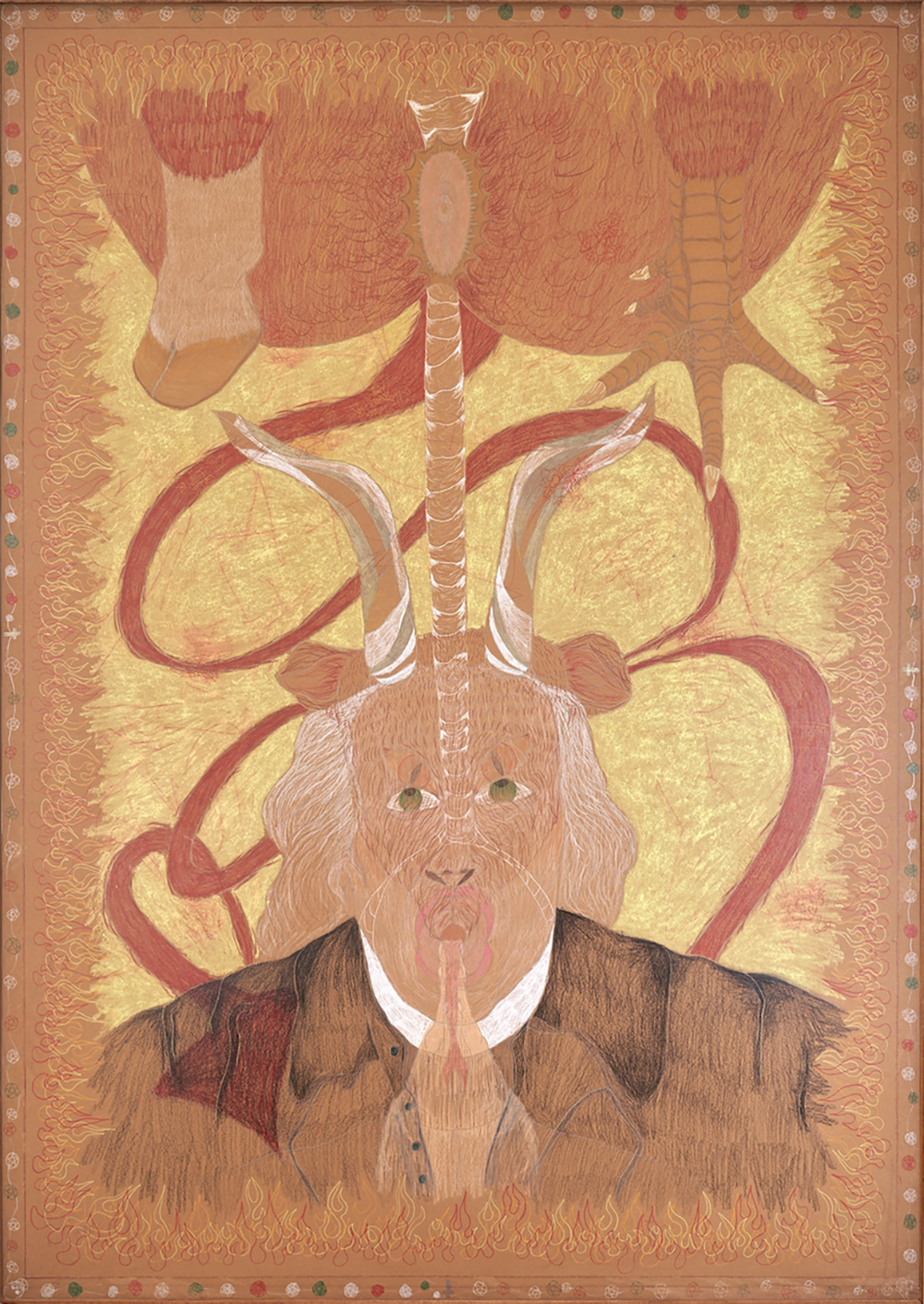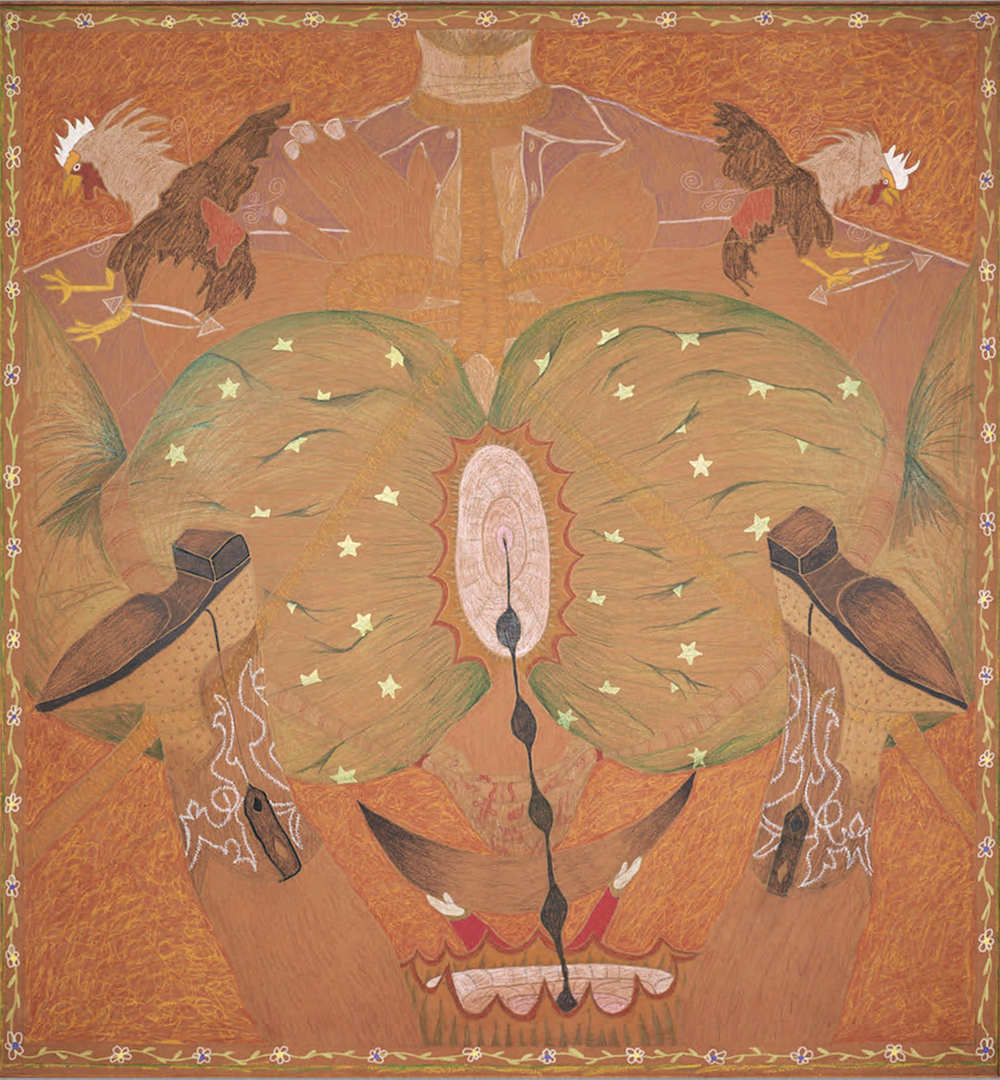Religious parochial dogma is often fraught with pedagogical conflicts in the spheres of doctrine, institutional curricula and, unsurprisingly—queer identity. Overlay these ideologies with Mexican-American cultural norms and concomitant conventions of masculinity, and you have potent fuel for artist Abel Guzmán’s exhibition “serás más macho” (you will be more macho). A major shift from the artist’s previous works, this engrossing show thoroughly dismantles prevailing archetypes.
The alluring and meditative installation of works on paper and sculptures, awash in sepia tones, compels the visitor to explore Guzmán’s unexpectedly lascivious and seductive lair. The carefully installed drawings, fashioned on brown paper with colored pencil, crayon and marker, are seamlessly sustained by a grouping of sculptures—3D manifestations of Guzmán’s sweeping vision. The works on paper command the gallery space: the surreal con tu bendición (with your blessing, 2022) anchors the series. A landscape of icons incorporates a male figure nearly turned inside out, his vaquero style cowboy boots askew and his exposed anus stuffed with anal beads—an object of both containment and pleasure—while encircled by a divine mandorla or halo. It’s a provocative and strikingly synchronized montage, in which masculinity, religion and sexual agency are orchestrated into a visual cacophony of male anxiety and an unapologetic evisceration of traditional religious icons.
No se dio cuenta de su propio mal presagio (he did not realize his own bad omen, 2022) refers to the double-headed serpent in Aztec mythology (maquizcoatl), who was bearer of bad omens. The Aztec ruling elites often gifted Spanish occupiers fine turquoise gifts of serpent representations, gestures that ultimately did little to mitigate their eventual subjugation—an allegorical irony. Macho macho man (2023) takes its cue from the classic Village People song, but its composition is an overt reference to Mexican tradition. Created in the manner of papel picado on traditional Amate paper, it depicts impossibly muscular men hoisting dumbbells in a kind of hyper-masculine ballet—a picture of fraught and ensnared power.

Abel Guzmán, ¡chinga tu padre!, 2022. Courtesy of la Beast gallery.
Positioned in the middle of the gallery, the nine sculptures are tantalizingly provocative. They function as a kind of power source— indeed, the entire series is titled “Energy Vessels” (all 2023). Composed of woven wire, pipe cleaners, latex and animal parts, these vessels are not to be taken lightly. Energy Vessel (No. 23) and (No. 24) read as companion works emitting and channeling an ethereal luminosity, rooted in familial brujeria traditions—a syncretic blend of folklore, traditional herbalism and religion. Both are oddly disconcerting and insistently compelling; the carefully constructed forms take on distorted qualities imbued with animism. Energy Vessel (No. 19) adds elements of chicken legs and a corn cob as a kind of blooming phallus. A daunting composition, it demands scrutiny: the deliberative, ritualized form is morphed into an equivocal alternative totem.
More breathing room would have eased absorbing the totality of the scene, but the beauty and audacity of the works on view are unambiguous—Guzmán’s aching catharsis and castigations of religion, masculinity and cultural norms is an overwhelming sensorial expedition.



















0 Comments